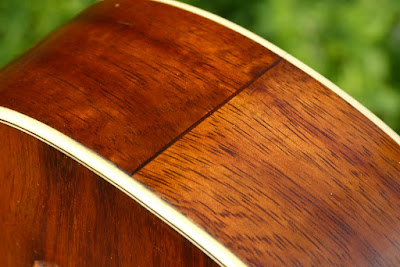1920s Martin-made Wurlitzer 2K Koa Ukulele
What a catch! This is a customer's uke that was in for repairs and I was very excited to get it in for work. It's clearly an early-20s Martin 2K model that was made for Wurlitzer's resale trade. The only difference compared to a regular Martin 2K from the time is the branding marks, slightly later Waverly-style tuners, and the use of maple for the nut and saddle rather than rosewood or ebony.
The sun wasn't cooperating for photos today but I can tell you that all the koa glows gloriously. After doing a bit of work (fret level/dress plus bridge reglue/mod) it plays perfectly, too and has that chipper, "koa tone." We all know it: sparkles like the tops of ocean waves. Yum.
The sun wasn't cooperating for photos today but I can tell you that all the koa glows gloriously. After doing a bit of work (fret level/dress plus bridge reglue/mod) it plays perfectly, too and has that chipper, "koa tone." We all know it: sparkles like the tops of ocean waves. Yum.
The "style 2" appointments include nice binding on the top and back as well as the more usual soundhole rosette. It's amazing how good the condition of the instrument is: the finish is beautiful.
Both the headstock front and back looked like they were rubbed down or scrubbed at one point -- so when I did the work I lightly top-coated and then buffed them out to bring them closer to the original gloss look. You can't tell in this photo because of the lighting but it would be hard to tell it wasn't 100% original, now.
The rosewood board is nice and elegant -- especially with those creamy clay dots.
The bits under the C & E strings that look slightly brighter (they're just catching the light from above) are compensated just a tiny bit for the owner's lefty string setup.
I know, I know -- more uke porn...
Curiously, this uke shipped from the factory with wood pegs. When I removed the tuners during work I could tell right away as the holes were tapered and had wear-marks/polished-edges from peg-turning in them. These period Waverly-style tuners work better, though, and I can assume that the better functionality is why they were swapped out during this instrument's first years of life.
The precisely-imprinted branding on the back of the headstock is bog-standard for Matin-made-for-others instruments.
Who can overlook the gorgeous original case? Green lining, too!



















Comments